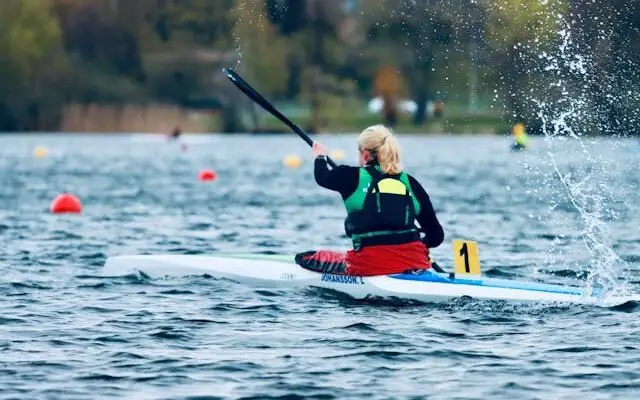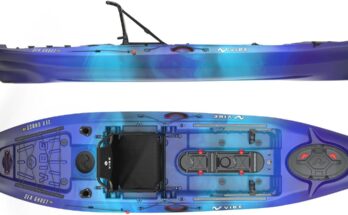When you’re thinking about a kayak journey, it’s helpful to know the time so you can inform other people when will be back home. But how Long Does It Take To Kayak A Mile?
Working out how much time it takes to kayak one mile is very important when you’re planning your trip. This helps give a general idea of the length of the journey. In this article, I will discuss everything that affects your kayaking speed and some important things you should know.
How long does it take to row a mile? The first time I asked this question was before we were going to kayak at Pinecrest Lake in California. What happens to be about 1 mile and a half long.
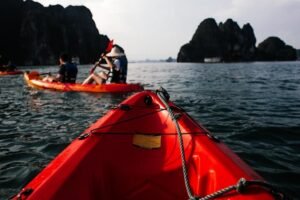
The Average Person Will Kayak a Mile in 30 Minutes
On average, a person will spend 20 to 30 minutes kayaking one mile. This speed isn’t the same for everyone, though; it can change a lot. Things are happening outside of your control (like weather and water conditions) that will impact you greatly, along with some things under your own power (such as skill or fitness).
It’s a good idea to know these things before you put on your life jacket and start paddling. Knowing what makes a kayak go fast will save you time and work in the end.
Factors That Affect Overall Miles per Hour
Most people will probably walk 2 to 3 miles in one hour. However, there are some important things you should know first.
A good guess at how far you can go is helpful for an easy kayaking trip, but the things below can make your distance change a lot (up or down).
Kayak Type
Let’s forget for a moment that many top brands of kayaks are just quicker than other good or beginner ones.
Usually, on calm shallow water where clams live, kayak types break down from fastest to slowest:
- Thin-beamed race kayaks – 20″ or less beam, very long, and very fast
- Sea Kayaks – Over 15′ length with beams in the 23″-24″ average, these kayaks are made to cover long distances very quickly
- Touring Kayaks– 15′ length with 26″ beam average, these are quicker than recreational kayaks
- Recreational Sit-inside Kayaks– 10′ length with 28″ beam average are medium speed
- Recreational Sit-on-top Kayaks– Stable but slower than sit-inside kayaks.
- Fishing Kayaks– Stable but slow, not meant for speed
- Whitewater Kayaks– Slow on calm water because they’re designed to rely on water flow for speed
- So, that touring kayak category above falls right into our 2-2.5 knots, 30 minutes to kayak a mile range. Paddling a fishing kayak, you can expect to add 10 or more minutes to that time, which would get you a 30-40 minute 1 mile kayak paddle. And paddling a sea kayak will shave about 10 minutes off that time, for a 20-minute mile in a kayak.
Hull Material and Speed
“Plastic” Kayak Speed
Kayaks made from one piece of plastic and molded in a certain way are slower than those with hulls made from composite or fiberglass materials. Also, the plastic shells get marks and scrapes which all add up to make the boat move slower.
Composite Kayak Speed
Most often, composite kayaks are about half a knot faster than plastic-hulled leisure boats. But, having a faster speed costs money.
Fiberglass/composite kayaks cost a lot more than the Rotomolded and Thermoform plastic hull ones.
But the material of a boat isn’t the only thing that affects how fast different types of kayaks can paddle 1 mile.
Kayak Length, Width, and Speed
We mentioned earlier that sea kayaks are the fastest kayaks for recreational speed. But why is that? Well, in general, sea and touring kayaks are longer, have narrower beams, and their hulls are made from smooth composite materials that slice through the water.
Then that’s our next factor. Generally speaking, narrow-beamed sea and touring kayaks are quicker if their size is the same as broader boats made for fun. This is because of the differences in their length and width ratios as much as their boat materials.
But the length-width ratios are another topic…but we’ll get there later.
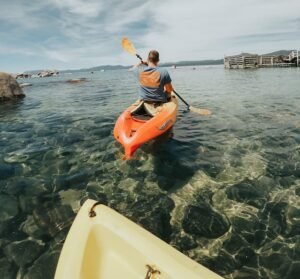
Weather Conditions and Speed
Wind is likely the main weather factor that determines how quickly you can kayak a mile. And the less heavy, shorter and wider your kayak is, it will be more affected by wind.
Plastic play kayaks often get pushed off course by side winds. This will impact how far you can move against the wind. A 10 mph headwind could make your one-mile kayak speed slower by adding a few minutes. But if you’re going 20 mph against a strong headwind, it will almost stop your movement.
If the wind is at your back, it might increase your speed – as the power from the wind pushes you through the water much faster than paddling manually on its own.
Wind resistance, wind speed, and overall wind conditions can slow you to a halt or greatly enhance your speed. Wind direction can either work for you or work against you, and it’s always a good idea not to count on the weather conditions, as they can change on a dime.
The good news is, as long as the wind direction doesn’t change, coming back the opposite way, you’ll get a speed boost with the wind at your back.
Water Conditions
The water’s state greatly influences how quick you can kayak. The three big things that can change how fast you kayak are the water flow, wind and waves.
Currents can either help or harm your movement, but it depends on their direction and power. Wind can help or block your progress based on where it’s coming from and how strong it is. Waves can also affect how fast you kayak, but they usually have a smaller effect than currents and wind.
The Amount Of Load With You
The average person can kayak a mile in about 30 minutes. But if you’re carrying a lot of weight, it’ll take you longer. Here’s a quick breakdown of how weight affects your kayaking speed:
- 10 pounds, you won’t notice a significant difference in your kayaking speed.
- 10-20 pounds, you may notice a slight decrease in your kayaking speed.
- 20-30 pounds, you may notice a moderate decrease in your kayaking speed.
- Over 30 pounds, you may notice a significant decrease in your kayaking speed.
So if you’re planning on kayaking a long distance, it’s best to pack as light as possible. Otherwise, you may be in for a long and arduous journey.
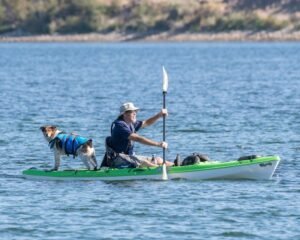
Your Experience Level
If you like play kayaks or are a master of sea kayaks, your total level can affect how far you go. Many kayakers are finding out their mile time because it’s easy to figure how much time they will need for longer trips.
But, most seasoned kayakers will go faster than usual. This isn’t only because their way of paddling is better, as with time you learn how to go slower.
A new kayaker won’t row quickly for a mile because they are still learning to paddle well.
The kind of kayaking you do could also change how long it takes to cover a mile – those who are just relaxing might be near the average of 30 minutes per mile, but speedy and experienced ocean kayakers will likely be at around 20.
Your Fitness Level
Being physically fit helps you paddle more miles and do it faster. Kayaking is a body exercise so the more stamina you have, the better you can keep up with good methods of paddling even in hard situations.
In simple words, if you are fitter it helps your paddling speed and lets you reach near the top speeds better. You will be able to row quicker and travel long ways, while minimizing the effects of fatigue.
Physical Ability & Experience
Physical ability is likely the most significant factor in how long someone would take to kayak a mile. Someone who is in good physical shape will be able to paddle faster and longer than someone who is not in good condition.
Furthermore, someone with more experience in kayaking will also be able to paddle faster and longer than someone new to the activity.
Paddlers with more experience will be able to kayak a mile in a shorter time than those new to the sport. This is because experienced paddlers will have a better understanding of how to paddle efficiently and will be able to maintain a higher level of endurance.
Are Pedal Kayaks Faster Over A Mile?
Pedal kayaks are typically faster than most traditional kayaks. This is because they use leg power instead of arm power.
Most people have more strength in their legs than their arms, meaning most people could pedal faster and cover longer distances more easily than if they were paddling.
Pedal kayaks can travel around twice as fast as standard kayaks so it can take less time to travel a mile in a pedal kayak compared to a paddle kayak.
Some pedal kayaks can reach speeds of around 8 mph in ideal conditions. By this estimate, it would take 7.5 minutes to travel a mile in a pedal kayak, as long as there was no wind or currents
What Are Some Things To Keep In Mind While Kayaking?
Kayaking is a great way to enjoy the outdoors and get some exercise, but it’s important to keep safety in mind while you’re on the water. Here are a few things to keep in mind while kayaking:
- Wear a life jacket at all times.
- Know your limits, and don’t push yourself too hard.
- Be aware of the weather conditions and plan accordingly.
- Make sure you know the area you’re kayaking in and understand the potential hazards.
- Bring a friend or family member with you and let someone know where you’re going.
These simple safety tips can help ensure that your kayaking trip is enjoyable and safe.
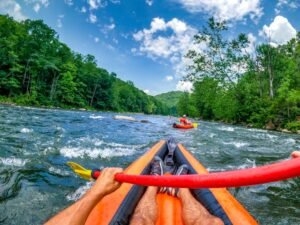
FAQ;s
1- How Fast Does A Kayak Travel?
A kayak can travel at a pretty good clip, depending on the conditions. A kayak can cruise at around 3-4 mph in calm water. A kayak can still move pretty quickly in rougher water but may only do 1-2 mph.
If you are new to kayaking, it might take a bit longer as you get used to the paddling motion. If you use a faster kayak, you might be able to make better time. And if the water is choppy, it can also slow you down.
2- How Long Does It Take To Kayak 1 Km?
It depends on several factors, including the Kayaker’s skill level, the type and size of the Kayak being used, the weather, and the water conditions. However, a rough estimate would be that it would take between 15 and 30 minutes to kayak 1 km.
3-How Long, Does It Take To Kayak 5 Miles?
It will take around two hours to kayak five miles if you are at a moderate pace. This can vary depending on your experience level, the type of Kayak you are using, and the current conditions. All things considered, though, two hours is a reasonable estimate for kayaking five miles.
4- How Long Does It Take To Kayak A Mile Downstream?
It takes the average person about 30min to Kayak a mile downstream. However, this time can vary depending on the current strength and the Kayaker’s skill.
5- How Long Does It Take To Kayak 10 Miles On A River?
Assuming you are kayaking downstream on a river with a moderate current, it would take approximately 5 hours to kayak 10 miles. If you are kayaking upstream on a river with a strong wind, it will take significantly longer, possibly upwards of five hours. Factors such as the strength of the current, the type of river, and your kayaking abilities would affect how long it would take to complete the 10-mile journey.
6- How Long Does It Take To Kayak 10 Km?
According to various sources, the average paddler can kayak 10 km in approximately 4-5 hours. However, this estimate can vary based on several factors, such as the strength and experience of the paddler, the type of Kayak being used, the water conditions, and the weather.
7- How Long Does It Take To Kayak 5km?
A typical person can paddle a kayak at about 3-4km/h, so it would take them 20 to 30 minutes to kayak 5km. However, experienced kayakers can paddle much faster and complete the same distance in under an hour. So, the answer to this question depends on the skill level of the Kayaker.
8- How Long Does It Take To Kayak 20 Miles?
Kayaking 20 miles generally takes between 7 and 8 hours, depending on the water conditions and the skill level of the Kayaker. More experienced kayakers can complete the distance in less time, while beginners may take longer.
Water conditions can also affect how long it takes to complete the journey, with calmer waters allowing for a faster trip.

